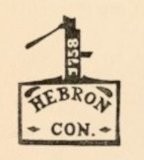
The Hebron Historical Society
Hebron, Connecticut
Enjoy Hebron - It's Here To Stay ™

May 31, 2005
By PETER MARTEKA, Courant Staff Writer
A strong wind blows through a field of grass that eventually will become hay for the horses and cows that playfully run around and graze in a nearby field. A Canada goose and her family of goslings wade into a small farm pond. Hay spills from the loft of a red barn in the distance.
Such pastoral scenes like this one at the Footehills farm off Gilead Street in Hebron are disappearing. Just about everyone has a memory of the family farm down the street or in their childhood town that is now a housing development or shopping center.
But not Footehills farm. The farm off Route 94 - otherwise known as Gilead Street - will always provide a gateway into the southwestern end of town. The 300 acres of fields, ponds, stone walls, hills and dales was preserved when the late Edward A. Foote and Marion O. Foote sold the development rights to the state in 1986.
At the time, it was the 100th farm and first in Hebron to take advantage of a program that allows farmers to retain ownership of their land for a promise to keep it in its agricultural state. Since then, Ned Ellis, owner of the 251-acre Mapleleaf Farm and the 173-acre Way Farm, has sold development rights to the state.
According to the Connecticut Farmland Trust, the state's highly productive and fertile land is disappearing at the rate of 7,000 acres a year. One only needs to drive along Route 83 in Ellington and see new housing developments and a proposed Big Y supermarket where a dairy farm and orchards once ruled.
Since 1985, the state has lost 21 percent of its farmland to residential housing and sprawl. The trust estimates that if this rate continues, all of the state's remaining farmland could disappear in less than two generations.
Edward Foote, who grew up on the Footehills family farm in the Gilead section of Hebron, predicted the future 45 years ago. As early as 1960, Foote was writing letters to the Connecticut Farm Bureau about the plight of farmers.
"Housing developments are eroding available farmland," he once wrote.
The forward-thinking farmer decided to preserve local farmland himself by purchasing land around his Footehills farm and buying other floundering farms so they wouldn't fall into the hands of developers. He eventually accumulated more than 850 acres in Gilead.
The Footes' efforts to save farmland were recently recognized by Gov. M. Jodi Rell during a ceremony attended by more than 85 people. Rell proclaimed May 22 as "Foote Family Day."
State Rep. Pamela Sawyer, R-Bolton, said it was the "right time" to honor a "major proponent of farmland preservation." When Sawyer first started representing the district of Bolton, Hebron, Andover and Marlborough, there were six dairy farms. Now there are two.
The state has spent $86 million to preserve about 30,000 acres of farmland since 1978, a fraction of the 130,000 acres that was the program's goal. The state, which had more than 4,500 dairy farms in 1950, has been losing its few remaining dairy farms at a rate of about 15 a year and has fewer than 200 left. Connecticut lost more than 700 farms of all types between 1997 and 2002.
"It's been an uphill fight over the years," Sawyer said about finding funding for farmland preservation. "I've seen all these little farms in Andover and Hebron die off. Now it's gentleman farming and not the big spreads you once saw.
"It's wonderful to help farmers like Ned Ellis, but they are the exception, not the rule," she said. "If you don't capture this now, they are gone forever. Ed Foote was a wonderful example of how to do it right."
James Murphy, chairman of Hebron's Open Space Land Acquisition Committee, met the Footes in the 1970s when he first moved to town and was invited to a Foote family picnic. As chairman of the Blackledge River Watershed Committee, a group set up to study and preserve the waterway, he worked closely with Foote because the headwaters flowed through the farm.
"The natural world and land preservation were some of his greatest concerns," Murphy said.
"Whenever they talked about land and natural resource protection, they were always very sincere. The whole story line with the Footes was they found a place they loved and wanted to make sure it was protected for generations to come. They deeply believed land is part of your heritage and it's the legacy you leave behind."
John Hibbard, who lives next door to the farm, said that Foote wanted to tie up as much property as possible along North Street and Gilead Street in an effort to preserve the rural quality of life in town.
"He had aspirations of saving a whole bit," said Hibbard, who served as executive director of the Connecticut Forest and Park Association for nearly 40 years. "He believed farmland and open space were interrelated. People in town want to have the rural places. Open spaces bring a certain ambiance to town, but the development pressures are high, too."
So next time you are traveling east along Route 94 from Glastonbury and you see the expanse of green in front of you, thank Edward and Marion Foote. Because that "gorgeous vista," as Sawyer calls it, was "not by chance, but by design."
Peter Marteka may be reached by phone at 860-647-5362, by mail at The Courant, 200 Adams St., Manchester, CT 06040, by e-mail at This email address is being protected from spambots. You need JavaScript enabled to view it. or by fax at 860-643-8548.
Re-printed from the Hartford Courant @2005